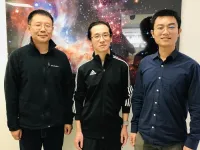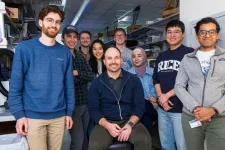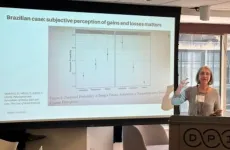(Press-News.org) A University of Sydney study investigating menu items on major online food delivery outlets and applications (apps) in Australia has found most advertised items are missing nutritional information that would otherwise help consumers make healthy choices.
Researchers say the findings show this information is largely absent or poorly provided on online food retail platforms and menu labelling laws need to keep up with increasing demand of online food delivery services.
The 2011 New South Wales Menu Labelling Scheme require large fast-food outlets to display both the average energy content (as Kilojoules) on menu items and the reference statement ‘the average daily energy intake is 8700 kJ’ at point of sale.
The kilojoule value must be next to the price of each item on menus: in store, at drive throughs, on internet ordering sites, and distributed via letterboxes. For example, if a burger on a menu item provides 2058 kJ.
The definition of large food outlets are franchises or chains with more than 20 locations in the state or 50 locations nationally.
From 10 randomly selected suburbs across Sydney, the study reviewed 43 unique large food outlets on online food delivery services.
A total of 482 menus from UberEats, Menulog and Deliveroo were reviewed.
Less than 6 percent of menus of food outlets on third party online food delivery applications (apps) such as UberEats, Menulog and Deliveroo had complete kilojoule labelling (where all items on the menu had kilojoule labelling). Since the study, Deliveroo no longer operates in Australia.
There were also large inconsistencies in kilojoule labeling between different locations for the same franchise store and between the type of delivery service, whether it was in house company owned apps (e.g. Dominos) or third-party delivery services (e.g. UberEats).
“The results are concerning and highlight the largely unregulated digital environment where young people increasingly use apps to make food purchases,” says lead author and PhD Candidate Sisi Jia, from the Charles Perkins Centre and Susan Wakil School of Nursing and Midwifery at the University of Sydney.
“Displaying the kilojoule content on a menu item is important to help people make informed health choices. There are multiple studies that show menu labelling having real world impact–- that consumers who were provided with nutritional information selected meals with significantly lower energy content,
“Although there is increasing demand of food delivery services, it is unknown how well menu labelling is implemented by online platforms,
“To our knowledge, there are currently no public health policies or nutritional labelling requirements that specifically cover online food delivery platforms.”
Key findings
Large food outlets on UberEats, Menulog and Deliveroo were found to have only 4.8 percent, 5.3 percent and 3.6 percent complete nutritional labeling respectively.
Only 35 percent of large fast-food franchise outlets on company apps such as MyMaccas had complete kilojoule labelling.
Over 75 percent of menu items from mid-sized food outlets (that had more than five locations across the state) could be classified as ‘unhealthy’ under independent guidelines although exempt from providing nutritional information under current laws.
The findings were published in Public Health Nutrition.
NSW Menu labelling laws need to be updated to reflect rise of online food delivery
Use of online food delivery serves has grown rapidly, including during the COVID-19 pandemic. In 2022, two-fifths of people in Australian capital cities were using those services and the primary users were millennials (born between 1981 and 1996) and Gen Z (born between 1997 and 2012).
The researchers say current NSW menu labelling laws were written with traditional food environments in mind and need to be updated.
“The inconsistent kilojoule labelling on online food delivery services, shows we need swift and clear leadership on how the NSW Menu Labelling scheme and any future schemes are applied on online food retail platforms,” says Dr Stephanie Partridge from the Charles Perkins Centre and Susan Wakil School of Nursing and Midwifery.
A previous study found over 80 percent of popular menu items advertised were classified as discretionary, meaning they are high in added salt, saturated fat, added sugar or low in dietary fibre according to the Australian Dietary Guidelines.
Online food delivery is also making it easier for people to buy food of low nutritional quality, say the researchers.
Co-author Dr Alice Gibson from the Menzies Centre for Health Policy and Economics and The Charles Perkins Centre said over 35 percent of children’s diets in Australia are comprised of discretionary junk foods which may increase risk of chronic diseases such as obesity, cardiovascular disease and type 2 diabetes.
“One of the aims of the 2021-2030 National Preventive Health Strategy is to improve access to and the consumption of a healthy diet,” says Dr Gibson.
“Food delivery services are a convenient service in response to consumer demand. The way we access food has become more ‘digital’ – public health nutrition policies need to keep up.”
-ENDS-
Declaration: The researchers declare no conflicts of interest. The article draws on research by former University of Sydney Masters students Sophia Cassano and Anna Jia.
END
Finding highlights the importance of including pet-owning households in surveillance programmes for antibiotic resistance
**Note: the release below is a special early release from the ESCMID Global Congress (formerly ECCMID, Barcelona, Spain, 27-30 April). Please credit the congress if you use this story**
**ECCMID has now changed name to ESCMID Global, please credit ESCMID Global Congress in all future stories**
Pet dogs and cats play an important role in the spread of antibiotic-resistant bacteria, new research be presented at the ESCMID Global ...
In a new paper published in JACS AU, researchers at the University of Illinois Urbana-Champaign analyzed the effects of solvation and ion valency on metallopolymers, with implications for critical materials recovery and recycling, and environmental remediation.
Chemical and biomolecular engineering (ChBE) professor Xiao Su led the research, which explored the science behind the selectivity “preferences” of monovalent and divalent anions towards redox polymers. In other words, why – when electrodes are coated with redox polymer films and potential is applied – one ion prefers the redox polymer while ...
RIVERSIDE, Calif. -- Last September, the James Webb Space Telescope, or JWST, discovered JWST-ER1g, a massive ancient galaxy that formed when the universe was just a quarter of its current age. Surprisingly, an Einstein ring is associated with this galaxy. That’s because JWST-ER1g acts as a lens and bends light from a distant source, which then appears as a ring — a phenomenon called strong gravitational lensing, predicted in Einstein’s theory of general relativity.
The total mass enclosed within the ring has two components: stellar and dark matter components.
“If ...
Clear guidelines should be established for the generation and processing of synthetic data to ensure transparency, accountability and fairness, a new study says.
Synthetic data - generated through machine learning algorithms from original real-world data - is gaining prominence because it may provide privacy-preserving alternatives to traditional data sources. It can be particularly useful in situations where the actual data is too sensitive to share, too scarce, or of too low quality.
Synthetic data differs from real-world data as it is generated by algorithmic models known as synthetic data generators, such as Generative Adversarial ...
Washington, April 12, 2024—Gender and racially based employment disparities, differences in perceptions of diversity, equity, and inclusion (DEI), and workplace discrimination remain significant issues in the field of educational measurement, according to a new report supported by the American Educational Research Association (AERA), the National Council on Measurement in Education (NCME), and Women in Measurement (WIM). Educational measurement professionals who work at universities, thinktanks, and other research organizations are ...
HOUSTON, April 10, 2024 - The University of Houston (UH) and Scotland’s Heriot-Watt University (HWU) signed a memorandum of understanding (MOU) today, marking the beginning of their partnership to foster global collaboration in education, research and innovation in the energy sector and beyond.
At the heart of the MoU lies a commitment to advance research that helps society deliver a just energy transition, with a particular emphasis on hydrogen – a critical element in the transition to sustainable energy ...
HOUSTON – (April 12, 2024) – Rice University engineers have developed the smallest implantable brain stimulator demonstrated in a human patient. Thanks to pioneering magnetoelectric power transfer technology, the pea-sized device developed in the Rice lab of Jacob Robinson in collaboration with Motif Neurotech and clinicians Dr. Sameer Sheth and Dr. Sunil Sheth can be powered wirelessly via an external transmitter and used to stimulate the brain through the dura ⎯ the protective ...
Jennifer Stinson a renowned researcher in the field of chronic pain management in children, has received the 2023 Barer-Flood Prize from the Canadian Institutes of Health Research (CIHR).
The prize, named in honour of the first two Scientific Directors of CIHR-IHSPR, Drs. Morris Barer and Colleen Flood, recognizes the highest-ranking senior-career investigator who identifies as a woman, and their research excellence.
Dr. Stinson, a Professor at the Lawrence Bloomberg Faculty of Nursing, Institute of Health Policy, Management and Evaluation, and Temerty Department of Anesthesiology & Pain Medicine, is being acknowledged ...
Modern Eurasian sheep predominantly belong to only two so-called genetic matrilineages inherited through the ewes. Previous research thereby assumed that genetic diversity must already have decreased rapidly in the early stages of domestication of wild sheep. Our study of a series of complete mitogenomes from the early domestication site Asıklı Höyük in central Anatolia, which was inhabited between 10,300 and 9,300 years ago, disproves this assumption: despite a millennium of human interference with the keeping and breeding of sheep, mitogenomic diversity remained invariably high, with five matrilineages ...
The theories offered by the dominant literature in political science today to try to explain the sources of the political polarization that has endangered democracy around the world are adequate for the United States and Europe, but do not make sense for the countries of Latin America. For this reason, greater collaboration among political scientists is needed to identify other, more plausible hypotheses for the phenomenon that the region is also experiencing.
The assessment was made by researchers participating in a panel discussion on democracy and social inclusion held on April 9 in Chicago (United States) during FAPESP Week Illinois https://fapesp.br/week/2024/illinois.
“There’s ...






